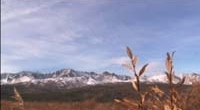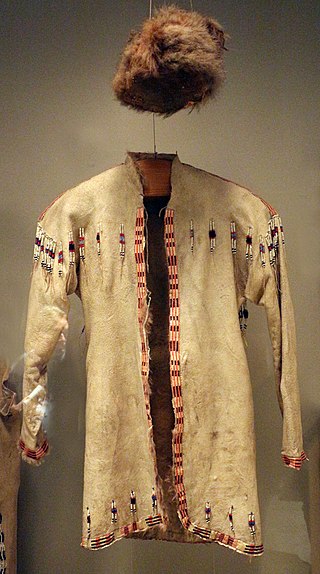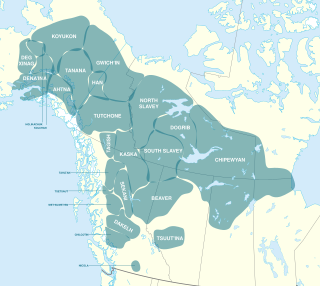
Tanacross is an endangered Athabaskan language spoken by fewer than 60 people in eastern Interior Alaska.

Athabaskan is a large family of Indigenous languages of North America, located in western North America in three areal language groups: Northern, Pacific Coast and Southern. Kari and Potter (2010:10) place the total territory of the 53 Athabaskan languages at 4,022,000 square kilometres (1,553,000 sq mi).

Na-Dene is a family of Native American languages that includes at least the Athabaskan languages, Eyak, and Tlingit languages. Haida was formerly included but is now considered doubtful. By far the most widely spoken Na-Dene language today is Navajo, also the most spoken indigenous language north of Mexico.

The Eyak are an Alaska Native people historically located on the Copper River Delta and near the town of Cordova, Alaska. Today, Eyak people live in Cordova, Yakutat, across Alaska, and the U.S.

Michael E. Krauss was an American linguist, professor emeritus, founder and long-time head of the Alaska Native Language Center. The Alaska Native Language Archive is named after him.

Deg Hitʼan is a group of Athabaskan peoples in Alaska. Their native language is called Deg Xinag. They reside in Alaska along the Anvik River in Anvik, along the Innoko River in Shageluk, and at Holy Cross along the lower Yukon River.
Deg Xinag is a Northern Athabaskan language spoken by the Deg Hitʼan peoples of the GASH region. The GASH region consists of the villages of Grayling, Anvik, Shageluk, and Holy Cross along the lower Yukon River in Interior Alaska. The language is severely endangered; out of an ethnic population of approximately 250 people, only 2 people still speak the language.

Holikachuk are a Yupikized Alaska Native Athabaskan people of the Athabaskan-speaking ethnolinguistic group to western Alaska. Their native territory includes the area surrounding the middle and upper Innoko River. Later in 1963 they moved to Grayling on the Yukon River.

Northern Athabaskan is a geographic sub-grouping of the Athabaskan language family spoken by indigenous peoples in the northern part of North America, particularly in Alaska, Yukon, and the Northwest Territories. The sprachraum of Northern Athabaskan languages spans the interior of Alaska to the Hudson Bay in Canada and from the Arctic Circle to the Canadian-US border. Languages in the group include Dane-zaa, Chipewyan, Babine-Witsuwitʼen, Carrier, and Slavey;. The Northern Athabaskan languages consist of 31 languages that can be divided into seven geographic subgroups.
Babine–Witsuwitʼen or Nadotʼen-Wetʼsuwetʼen is an Athabaskan language spoken in the Central Interior of British Columbia. Its closest relative is Carrier. Because of this linguistic relationship together with political and cultural ties, Babine–Witsuwitʼen is often referred to as Northern Carrier or Western Carrier. Specialist opinion is, however, that it should be considered a separate, though related, language.
Koyukon is the geographically most widespread Athabascan language spoken in Alaska. The Athabaskan language is spoken along the Koyukuk and the middle Yukon Rivers in western interior Alaska. In 2007, the language had approximately 300 speakers, who were generally older adults and bilingual in English. The total Koyukon ethnic population was 2,300.

Doyon, Limited, is one of thirteen Alaska Native Regional Corporations created under the Alaska Native Claims Settlement Act of 1971 (ANCSA) in settlement of aboriginal land claims. Doyon was incorporated in Alaska on June 26, 1972. Headquartered in Fairbanks, Alaska, Doyon is a for-profit corporation with about 18,000 Alaska Native shareholders primarily of Alaskan Athabaskan descent.

As of 2020, Alaska has a population of 733,391.
James Kari is an American linguist and Professor Emeritus with the Alaska Native Language Center at the University of Alaska Fairbanks (UAF) specializing in the Dene of Alaska. He served on the faculty of UAF from 1973 to his retirement in 1997.
Holikachuk or Huligachagat is an abandoned village on the Innoko River in the U.S. state of Alaska.
Alaska Natives are a group of indigenous people that live in the state of Alaska and trace their heritage back to the last two great migrations that occurred thousands of years ago. The Native community can be separated into six large tribes and a number of smaller tribes, including the Iñupiat, Yup'ik, Aleut, Tlingit, Haida, Tsimshian, and others. Even with just a small number of communities that make up the entire population, there were more than 300 different languages that the Natives used to communicate with one another.
Proto-Athabaskan is the reconstructed ancestor of the Athabaskan languages.

The Alaskan Athabascans, Alaskan Athapascans or Dena are Alaska Native peoples of the Athabaskan-speaking ethnolinguistic group. They are the original inhabitants of the interior of Alaska.

The Tanana Athabaskans, Tanana Athabascans, or Tanana Athapaskans are an Alaskan Athabaskan people from the Athabaskan-speaking ethnolinguistic group. They are the original inhabitants of the Tanana River drainage basin in east-central Alaska Interior, United States and a little part lived in Yukon, Canada. Tanana River Athabaskan peoples are called in Lower Tanana and Koyukon language Ten Hʉt'ænæ, in Gwich'in language Tanan Gwich'in. In Alaska, where they are the oldest, there are three or four groups identified by the languages they speak. These are the Tanana proper or Lower Tanana and/or Middle Tanana, Tanacross or Tanana Crossing, and Upper Tanana. The Tanana Athabaskan culture is a hunter-gatherer culture with a matrilineal system. Tanana Athabaskans were semi-nomadic and lived in semi-permanent settlements in the Tanana Valley lowlands. Traditional Athabaskan land use includes fall hunting of moose, caribou, Dall sheep, and small terrestrial animals, as well as trapping. The Athabaskans did not have any formal tribal organization. Tanana Athabaskans were strictly territorial and used hunting and gathering practices in their semi-nomadic way of life and dispersed habitation patterns. Each small band of 20–40 people normally had a central winter camp with several seasonal hunting and fishing camps, and they moved cyclically, depending on the season and availability of resources.

The Upper Kuskokwim people or Upper Kuskokwim Athabaskans, Upper Kuskokwim Athabascans, and historically Kolchan, Goltsan, Tundra Kolosh, and McGrath Ingalik are an Alaskan Athabaskan people of the Athabaskan-speaking ethnolinguistic group. First delineation of this ethnolinguistic group was described by anthropologist Edward Howard Hosley in 1968, as Kolchan. According to Hosley, "Nevertheless, as a group possessing a history and a culture differing from those of its neighbours, the Kolchan deserve to be recognized as an independent group of Alaskan Athapaskans." They are the original inhabitants of the Upper Kuskokwim River villages of Nikolai, Telida, and McGrath, Alaska. About 25 of a total of 100 Upper Kuskokwim people still speak the language. They speak a distinct Athabaskan language more closely related to Lower Tanana language than to Deg Xinag language, spoken on the middle Kuskokwim. The term used by the Kolchan themselves is Dina'ena, but this is too similar to the adjacent Tanana and Tanaina for introduction into the literature. Nowadays, the term used by the Kolchan themselves is Dichinanek' Hwt'ana. Their neighbors also knew them by this name. In Tanaina they were Kenaniq' ht'an while the Koyukon people to the north referred to them as Dikinanek Hut'ana. The Upper Kuskokwim Athabaskan culture is a hunter-gatherer culture and have a matrilineal system. They were semi-nomadic and lived in semi-permanent settlements.











